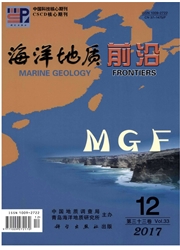

 中文摘要:
中文摘要:
近年南海西北陆缘西沙东北海域发现大型多金属结核,尽管其外观与大洋结核别无二致,具有个体大、外部形态规整、层状结构清晰的特点,但其地球化学组成与大洋多金属结核存在明显差别:TMn/TFe的比值小,仅为0.73,富Fe、Si、A1、稀土元素而贫Mn、Cu、Co、Ni。Be同位素质谱法测年和钙质超微生物地层学方法研究表明,结核生长速度达7.41~15.38mm/Ma,远大于大洋多金属结核的平均生长速率和以前发现于南海北部的多金属结核。依据其综合特征,初步认定其为边缘海区域赋存的一种新型多金属结核。该类型结核所蕴含丰富的边缘海区域古海洋、古气候、古环境信息,有助于探讨新生代末期青藏高原隆升、东亚季风加强、北半球冰期发生等重大地质事件所引起的区域沉积响应。
 英文摘要:
英文摘要:
Recently, large polymetallic nodules were found in the northeast of Xisha sea area at the northwest margin of the South China Sea. Although their appearances are similar to those of oceanic nodules.large in size, regular in appearance and with clear layering structure, there are evident differ- ences from oceanic polymetallic nodules in geochemical composition, small in TMn/Tfe ratio(only 0. 73) ,rich in Fe,Si,Al and rare earth element and poor in Mn,Cu,Co,and Ni. Be isotopic mass spec- trometry and calcareous nannofossil biostratigraphic method show that the nodule growth rate can be as high as 7.41- 15.38 mm/Ma,much larger than those of oceanic nodules and polymetallic nodules previously found in the north of the South China Sea. According to comprehensive features of the nod- ules,the authors preliminarily suggested that these nodules belonged to a new type existing in the marginal sea area and they contained rich information of paleo-ocean, paleoclimate and paleoenviron- ment,and thus they were very helpful to study regional sedimentary response to great geologic events such as Qinghai-Tibet Plateau uplift, East Asian monsoon intensifying and glaciation in the North Hemisphere.
 同期刊论文项目
同期刊论文项目
 同项目期刊论文
同项目期刊论文
 The Enrichment Regularity of Rare Earth Elements and Resource Characteristics in Polymetallic Nodule
The Enrichment Regularity of Rare Earth Elements and Resource Characteristics in Polymetallic Nodule The distributed characteristics and controlling factors of the formation of coastal wetlands in Tang
The distributed characteristics and controlling factors of the formation of coastal wetlands in Tang Mechanism of frequency conversion vibration stimulating exploiting technology with marine gas hydrat
Mechanism of frequency conversion vibration stimulating exploiting technology with marine gas hydrat The Late Mesozoic Granodiorites from the Southwest Basin in the South China Sea and Its Tectonic Imp
The Late Mesozoic Granodiorites from the Southwest Basin in the South China Sea and Its Tectonic Imp 期刊信息
期刊信息
